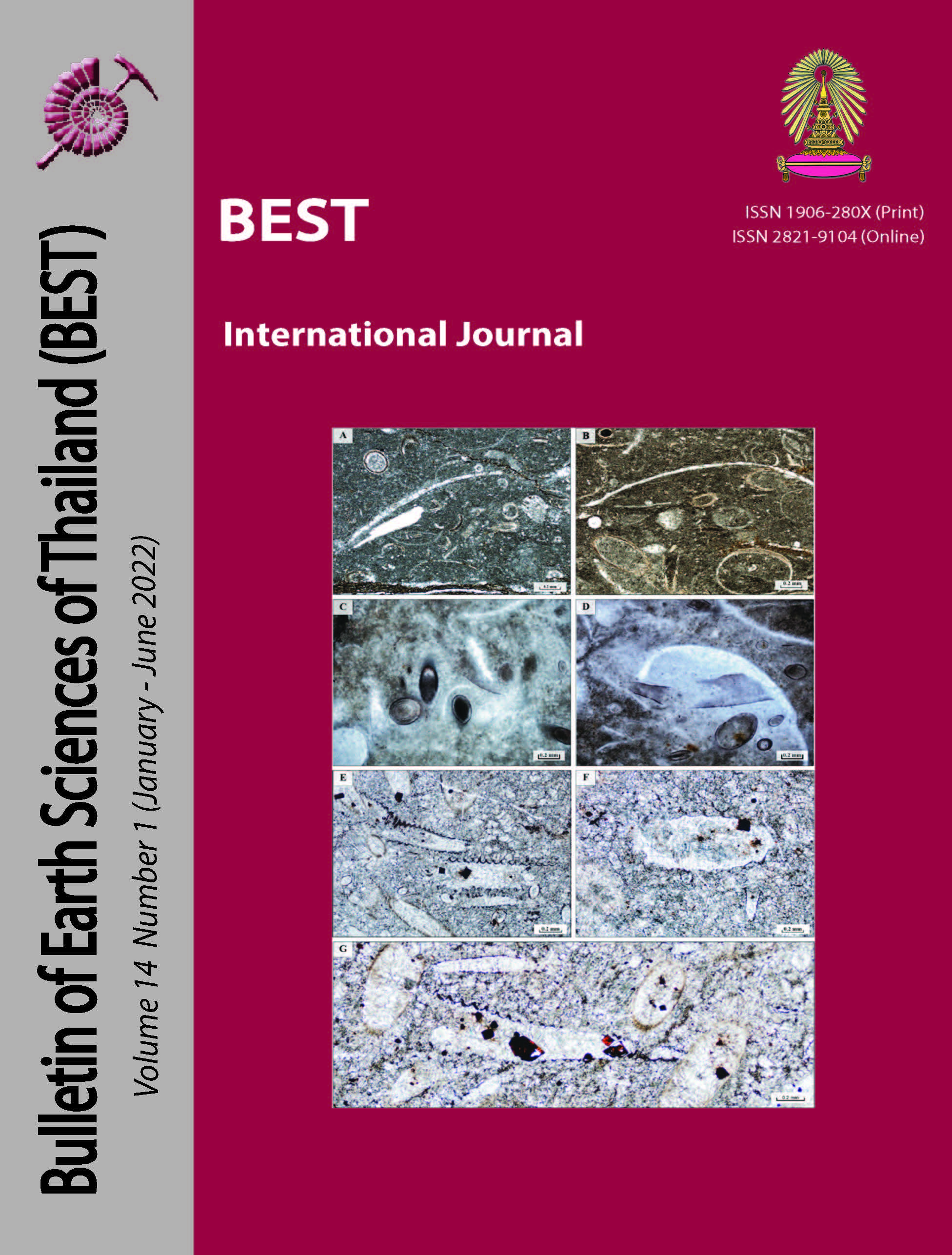Seismicity rate change along the strike-slip fault system at the Thailand-Myanmar border: Implications for upcoming earthquakes
Main Article Content
Abstract
In this study, both the temporal and spatial distributions of the seismicity rate changes were examined along the strike-slip fault system (SSFS) at the Thailand-Myanmar border. Based mainly on the completeness seismicity data, the relationships between the rate change anomalies and the proceeding earthquakes were checked empirically. Utilizing the obtained optimal condition of N = 25 events and Tw = 2 y, the results revealed that the lower the seismicity rate, the higher the probability of a subsequent earthquake occurrence. Hence, both spatial and temporal distributions of the rate changes were evaluated from the present-day seismicity data for 2005–2016. The maximum obtained Z value (7.3) was found in (i) 2006.43–2007.12 and 2012.64–2013.07 at northwestern Naypyidaw (96.50oE, 20.39oN) and (ii) in 2012.49 at the northeastern part of the SSFS (97.75oE, 21.89oN). This agrees well with those areas proposed previously by analysis of the frequency-magnitude distribution b-value. Therefore, effective mitigation plans should be contributed urgently, for Naypyidaw, the new capital city of Myanmar.
Article Details

This work is licensed under a Creative Commons Attribution-NonCommercial-NoDerivatives 4.0 International License.
Copyright © 2008 Department of Geology, Faculty of Science, Chulalongkorn University. Parts of an article can be photocopied or reproduced without prior written permission from the author(s), but due acknowledgments should be stated or cited accordingly.
References
Charusiri, P., Kosuwan, S., Saithong, P., Khaowiset, K., Pananont, P., Thitimakorn, T., and Pailoplee, S., 2011, Active fault study in Kanchanaburi province, Western Thailand. Technical report, Thailand Research Fund, Bangkok, Thailand, 252p. [in Thai with English abstract]
Department of Mineral Resources, 2007, Paleo-earthquake along the Sri Sawath and Three Pagoda Fault Zones, Kanchanaburi province. Technical report, Department of Mineral Resources, Bangkok, Thailand, 127p. [in Thai with English abstract]
Gardner, J.K., and Knopoff, L., 1974, Is the sequence of earthquakes in Southern California, with aftershocks removed, Poissonian?. Bulletin of the Seismological Society of America, 64, 363−367.
Gutenberg, B., and Richter, C.F., 1944, Frequency of earthquakes in California. Bulletin Seismological Society of America, 34, 185−188.
Habermann, R.E., 1983, Teleseismic detection in the Aleutian Island Arc. Journal of Geophysical Research, 88, 5056–5064.
Mogi, K., 1969, Some feature of recent seismic activity in and near Japan (2), Activity before and after great earthquake. Bulletin of the Earthquake Research Institute, Tokyo, 47, 395–417.
Nutalaya, P., Sodsri S., and Arnold, E.P., 1985, Series on seismology-volume II-Thailand. In E.P Arnold (ed.), Technical report, Southeast Asia Association of Seismology and Earthquake Engineering, 402p.
Nuttee, R., Charusiri, P., Takashima, I., and Kosuwan S., 2005, Pakeo- earthquakes along the southern segment of the Sri Sawat fault, Kanchanaburi, western Thailand: Morphotectonic and TL-dating evidence. Proceedings of the International Conference on Geology, Geotechnology and Mineral Resources of Indochina (GEOINDO 2005) 28-30 November 2005, Khon Kaen, Thailand, 542–554.
Pailoplee, S., 2014, Earthquake activities along the strike-slip fault system on the Thailand-Myanmar border. Terrestrial, Atmospheric and Oceanic Sciences, 25, 483−490.
Pailoplee, S., 2016, Mapping of b-value anomalies along the strike-slip fault system on the Thailand–Myanmar border: Implications for upcoming earthquakes. Journal of Earthquake and Tsunami, 10, 1671001-1−13.
Pailoplee, S., and Charusiri, P., 2016, Seismic hazards in Thailand: a compilation and updated probabilistic analysis. Earth, Planets and Space, DOI: 10.1186/s40623-016-0465-6.
Pailoplee, S., Sugiyama, Y., and Charusiri, P., 2009, Deterministic and probabilistic seismic hazard analyses in Thailand and adjacent areas using active fault data. Earth, Planets and Space, 61, 1313–1325.
Rhodes, B.P., Perez, R., Lamjuan, A., and Kosuwan, S., 2004, Kinematics and tectonic implications of the Mae Kuang Fault, northern Thailand. Journal of Asian Earth Sciences, 24, 79−89.
Sobolev, G.A., 1995, Fundamental of Earthquake Prediction.
Wells, D.I. and Coppersmith, K.I. 1994. New empirical relationship among magnitude, rupture, width, rupture area, and surface displacement. Bulletin of the Seismological Society of America 84, 974-1002. Electromagnetic Research Centre, Moscow. 161p
Sukrungsri, S., and Pailoplee, S., 2015, Precursory seismicity changes prior to major earthquakes along the Sumatra-Andaman subduction zone: a region-time-length algorithm approach. Earth, Planets and Space, DOI 10.1186/s40623-015-0269-0.
Wiemer, S., 2001, A software package to analyse seismicity: ZMAP. Seismological Research, 72, 373−382.
Wiemer, S., and Wyss, M., 1994, Seismic quiescence before the Landers (M = 7.5) and Big Bear (M = 6.5) 1992 Earthquakes. Bulletin of the Seismological Society of America, 84, 900–916.
Wyss, M., 1991, Reporting history of the central Aleutians seismograph network and the quiescence preceding the 1986 Andreanof Island earthquake. Bulletin of the Seismological Society of America, 81, 1231–1254.
Wyss, M., and Habermann, R.E., 1988, Precursory seismic quiescence. Pure and Applied Geophysics, 126, 319–332.
Wyss, M., and Martirosyan, A., 1998, Seismic quiescence before the M7, 1988, Spitak earthquake, Armenia. Geophysical Journal International, 134, 329–340.
Zuniga, F.R., and Wiemer, S., 1999, Seismicity patterns: are they always related to natural causes?. Pageoph, 155, 713−726.
Wintle, A.G. and Murray, A.S. 1999. Luminescence sensitivity changes in quartz. Radiation Measurements 30(1), 107-118.
Won-in, K. 1999. Neotectonic Evidence along the Three-Pagoda Fault Zone, Changwat Kanchanaburi. M. Sc. Thesis, Department of Geology, Chulalongkorn University, Bangkok, Thailand, 214p.
Wong, I., Fenton, C., Dober, M., Zachariasen, J. and Terra, F. 2005. Seismic hazard evaluation of the Tha Sae project, Thailand. Technical report, Punya Consultants Co. Ltd., 118p.
Wood, S.H. 2001. Slip rate estimate from offset stream valley volume, and dedudation rate: Mae Chan, Northern Thailand. EOS. Trans. Am. Geophys. Union 82, pp.932.
Yunan Seismological Bureau 1997. Three Pagoda Fault Zone from downstream of KhaoLaem dam to Sai Yok waterfall. Technical report, Yunan Seismological Bureau, Yunan Province, China.
Zander, A, Duller, G.A.T. and Wintle, A.G. 2000. Multiple and single aliquot luminescence dating techniques applied to quartz extracted from Middle and Upper Weichselian loess, Zemechy, Czech Republic. Journal of Quaternary Sciences 15(1), 51-60.
Zoback, M.L. 1992. First-and second-order patterns of stress in lithosphere: The World Stress Map Project. Journal of Geophysical Research 97, 11703-11728.


